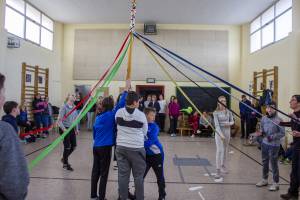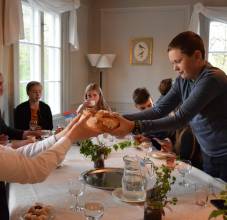Goals
- Strengthen safeguarding of living heritage by integrating it into formal education.
- Use living heritage as a resource and communication medium to enhance social and inter-cultural cohesion, learning from others, and understanding the meaning of cultural diversity.
- Allow young people to define and voice what they regard as important living heritage.
Heritage Hubs was a two-year project related to the European Year of Cultural Heritage 2018, co-funded by the Creative Europe programme of the European Union. It brought together 10-16 years-old school children from Finland, Serbia and Spain, to share examples of their cultural heritage via digital platforms and to interpret the cultural heritage of others through face-to-face interactions at home and abroad. The integration of cultural heritage, both tangible and intangible, into formal education was seen as a valuable learning resource and communication medium, through which different cultural practices and values could be used to advocate for social and inter-cultural cohesion.
The project was coordinated by the Association of Cultural Heritage Education in Finland in partnership with La Fundación San Millán de la Cogolla in Spain, the Centre for Urban Development in Serbia, and VITECO E-learning solutions in Italy.
Understanding Cultural Heritage
The project explicitly recognized that cultural heritage consists not only of monuments and collections of objects, but includes traditions or living expressions that are inherited from ancestors and passed on to their descendants. This form of intangible or living heritage includes traditions, performing arts, social practices, rituals, festive events, knowledge and practices concerning nature and the universe or the knowledge and skills to produce traditional crafts. The experiences developed between schools were driven by the notion that encounters with people from different cultures reduces cultural prejudices, encourages intercultural dialogue, and increases mutual respect for others’ ways of life. In the process of learning about other cultures and their living heritage, students also learned about themselves and their own cultural identity.
The starting point of Heritage Hubs was to actively engage children and young people in defining tangible and intangible cultural heritage that is meaningful to themselves, and to strengthen their role in the discourse around cultural heritage. The idea behind the project was to recognize that the choices and actions of the young generation living and growing in Europe today, would be crucial in deciding the significance of cultural heritage in their lives, its transmission and transformation, the continuity of stories and traditions, and the development of new forms of cultural heritage that they will be creating for Europe in the future. It was noted that their active participation and opinions about living heritage are necessary to understand the plurality and diversity of identities and cultural expressions at local, national and European levels. It also helps in constructing a more sustainable present and future for Europe and beyond.
Learning, Interpreting and Sharing Heritage
Heritage Hubs began as a heritage sharing project to be tested in school pilots that were organised at 11 schools in Finland, Serbia and Spain during 2018-2019. The pilots included teacher training and different types of heritage workshops with pupils. The specially designed Heritage hubs didactic package was tested to support the teachers in various phases of project implementation in schools. This largely consisted of three phases: learning about cultural heritage, interpreting heritage, and sharing heritage. As an example of the learning phase, students used a specifically designed tool— ‘a wheel chart of sustainability’—to explore the connections between living heritage with social, economic and environmental sustainability. The Wheel Chart divided the four different dimensions of sustainable development (ecological, economic, social and cultural) into eight different subject areas with three questions each and was used as a tool for dialogue and development. This also helped the students to explore and reflect on different living heritage elements of interest to them.
For ‘interpreting heritage’, pupils were encouraged to consider and reflect on their relationship with (their own and others’) cultural heritage. The idea was to support their engagement and interaction with cultural heritage by encouraging new creative ways and forms of expressing, presenting, and interpreting cultural heritage. Pupils in Finland, Serbia and Spain created video presentations on heritage themes that they regarded as meaningful and important to represent their culture. This multidisciplinary and multimedia learning experience helped the pupils to familiarize themselves with the heritage of others, interpret it and then present their interpretations to the visiting students from the partner schools.
In the ‘sharing’ phase, the emphasis was on the discovery of cultural similarities and commonalties as a valuable uniting force between students of schools in different countries of Europe. Awareness was raised about how living heritage is safeguarded through cultural transmission between different generations as well as between peers, through various types of social relations and intercultural contacts. In essence, this was a social learning process that required multiple perspectives and takes on various forms of cultural heritage.
Based on participant feedback, their experiences and empirical data collected during the project’s implementation, a Heritage Hubs methodology for transnational cultural heritage education was further developed into a ‘Manual for Cultural Heritage Education’, which would provide sustainable results and long-term effects in the field of heritage education throughout Europe.
Project Outputs
- 11 pilot projects on sharing heritage (4 in Finland, 4 in Spain, 3 in Serbia)
- Heritage Hubs Manual for Cultural Heritage Education (Available in English, Swedish, Finnish, Spanish and Serbian).
- Didactic tools, including ICH: Wheel Chart of Sustainability , School Theme Guide, Digital Tools Guide, Teachers’ Handbook, Heritage Hubs leaflets, Posters and other dissemination material (Available here in different languages)
- Relevant Heritage Hubs Videos (list).
- Heritage Hubs Interviews: Student’s and teachers’ impressions of an impactful experience
- Dedicated website sharing Heritage Hubs experiences and project results
Impact
Heritage Hubs was a meaningful learning experience for the participants. The voices of the students and their views on living heritage were foremost in devising and producing the presentations, events and activities of the project. They demonstrated that ICH is versatile, changing and carries the power to unite people. It was observed that the Heritage Hubs aroused interest in cultural heritage not only among participating pupils and teachers, but also among their families and neighbours. As a consequence, living heritage became a new link between pupils, teachers, parents and the wider community. The Heritage Hubs project has also won the European Heritage Europa Nostra Awards 2021 in the category of Education Training and Awareness-Raising. An introductory Video of the project was also developed for the Europa Nostra Award 2021.
The participant’s direct engagement with their own and others’ ICH widened their understanding of heritage, and enhanced awareness of its living, versatile, fluid and constantly evolving nature. They also noted the presence of cultural heritage in their daily lives and ordinary activities. Such increased familiarity with living heritage at the local and/or European level helps in strengthening the safeguarding of ICH, as youth are more likely to appreciate living heritage and take responsibility for its maintenance and transmission.
The project activities also activated participants’ cultural sensitivity and adaptability, which was in turn strengthened by the experiences. It developed their cultural and personal empathy skills. Participants reported overcoming many pre-existing cultural prejudices, and increased respect for their peers and their intangible cultural heritage. It was established through the project, that transnational and cross-cultural intangible heritage education is a valuable resource for raising awareness of living heritage and draws attention to cultural similarities and connections.
“…..Heritage education is a social learning process in essence. This means that learning from heritage is particularly effective when it is active, when it happens in direct social encounters and immediate cultural environments.”
- Aleksandra, National Coordinator, Heritage Hubs, Serbia

© Fundacion San Millan de la Cogolla 2019

© AHEF, 2019
See the main page for this project here.
The content of the projects and documents referenced in this platform do not imply the expression of any opinion whatsoever on the part of UNESCO, including designations employed concerning the legal status of any country, territory, city or area or of its authorities or concerning the delimitation of its frontiers or boundaries.
